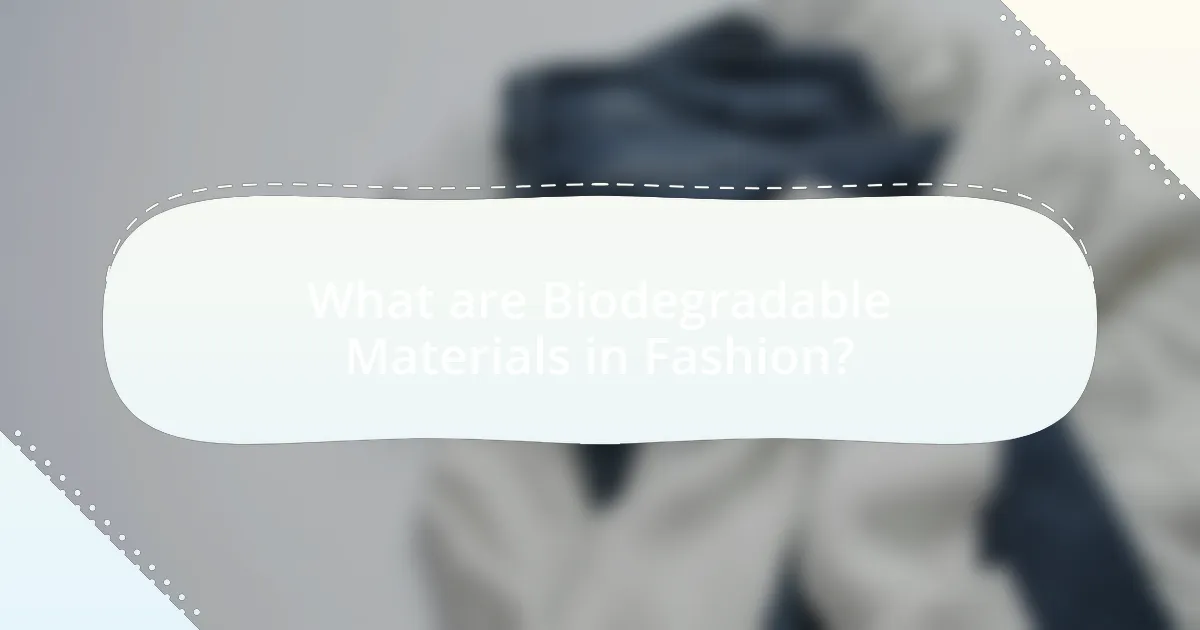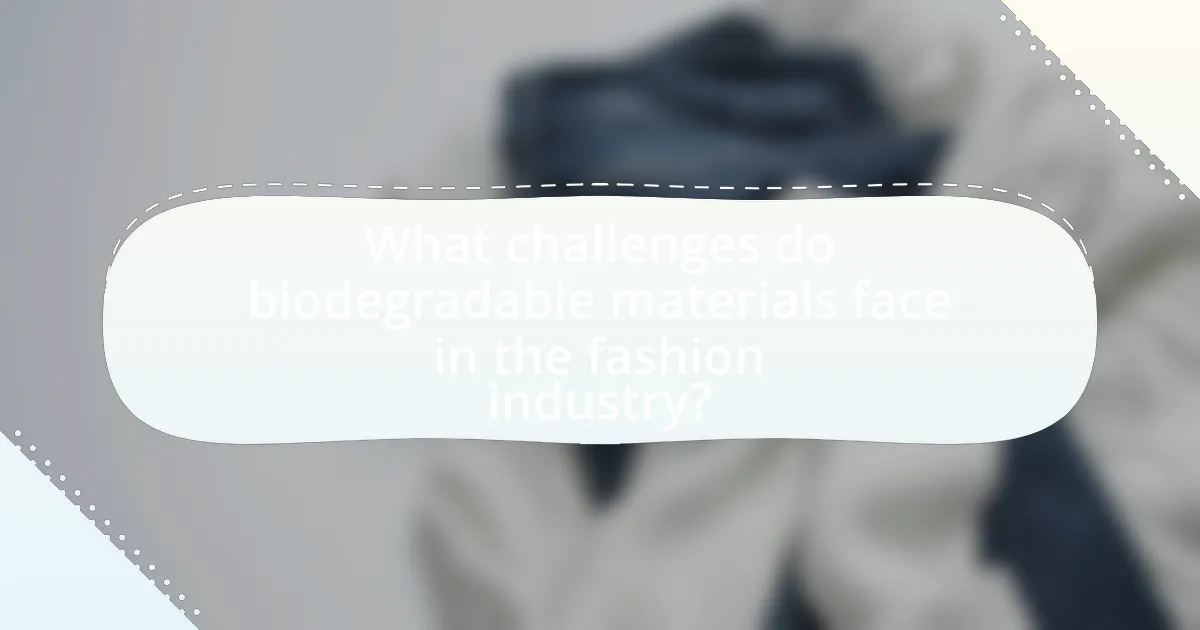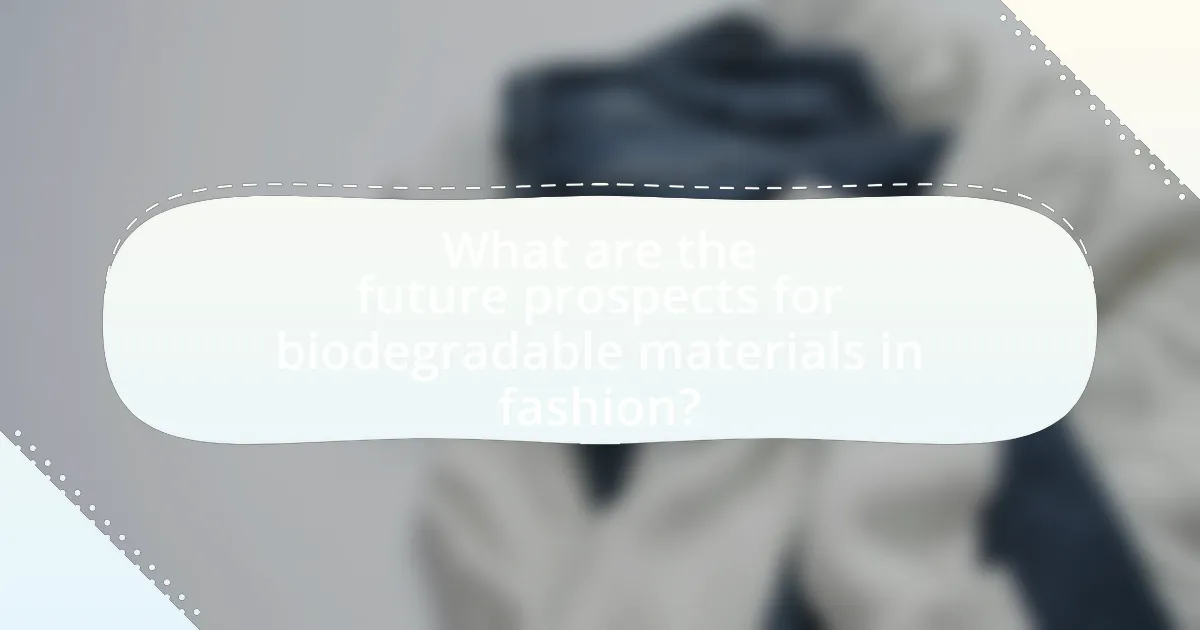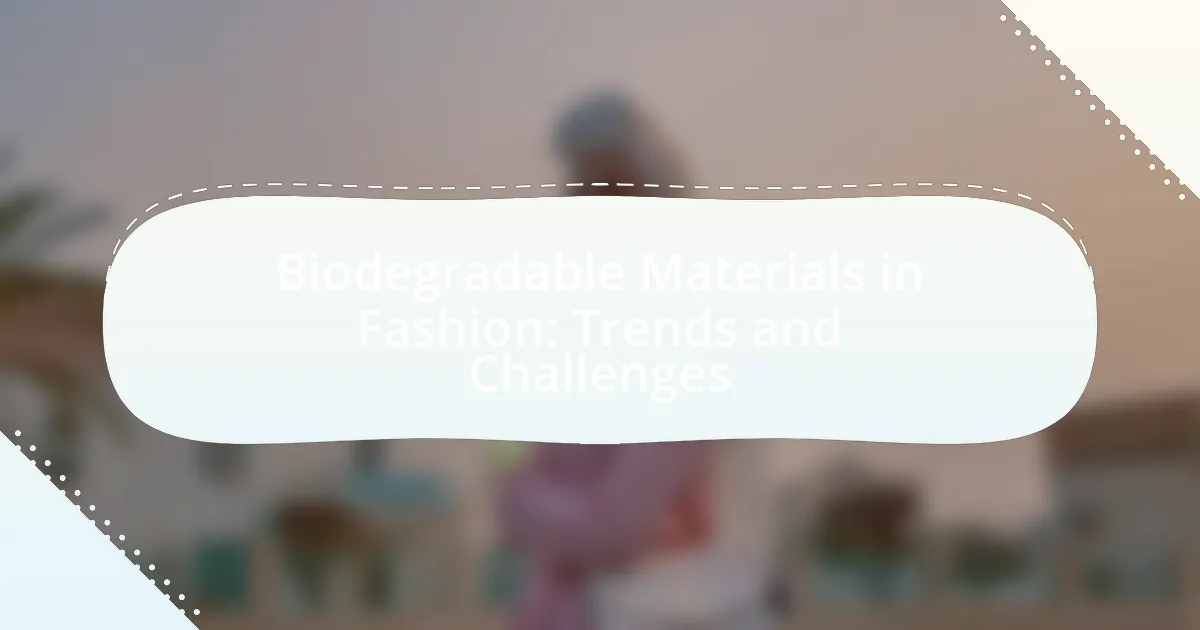Biodegradable materials in fashion refer to substances that can naturally decompose through biological processes, significantly reducing environmental impact compared to traditional textiles. This article explores the characteristics, types, and importance of biodegradable materials, such as organic cotton, hemp, and Tencel, in addressing the textile waste crisis. It also examines the differences between biodegradable and conventional materials, emerging trends, consumer preferences, and the role of fashion brands in promoting sustainability. Additionally, the article discusses the challenges and barriers to adopting biodegradable materials, including cost factors, technological limitations, and consumer misconceptions, while highlighting future prospects and best practices for successful implementation in the fashion industry.

What are Biodegradable Materials in Fashion?
Biodegradable materials in fashion are substances that can decompose naturally through the action of living organisms, typically within a specific timeframe. These materials, such as organic cotton, hemp, and Tencel, are designed to break down into non-toxic components, reducing environmental impact compared to conventional textiles. For instance, organic cotton is grown without synthetic pesticides and fertilizers, making it more sustainable, while Tencel, made from sustainably sourced wood pulp, is known for its biodegradability and low environmental footprint. The use of biodegradable materials in fashion addresses the growing concern over textile waste, as approximately 92 million tons of textile waste are generated globally each year, highlighting the need for more sustainable practices in the industry.
How do biodegradable materials differ from traditional materials?
Biodegradable materials differ from traditional materials primarily in their ability to decompose naturally through biological processes. Traditional materials, such as plastics and synthetic fibers, can take hundreds of years to break down, often leading to environmental pollution. In contrast, biodegradable materials, like organic cotton or polylactic acid (PLA), are designed to break down within a shorter time frame, typically within months to a few years, when exposed to natural environmental conditions. This difference is significant as it directly impacts waste management and environmental sustainability, reducing landfill accumulation and pollution associated with non-biodegradable waste.
What are the key characteristics of biodegradable materials?
Biodegradable materials are substances that can decompose naturally through the action of microorganisms, resulting in non-toxic byproducts. Key characteristics include their ability to break down into natural elements within a specific timeframe, typically ranging from a few weeks to several months, depending on environmental conditions. Additionally, biodegradable materials are often derived from renewable resources, such as plant-based materials, which contribute to sustainability. They also tend to have lower environmental impact compared to conventional plastics, as they reduce landfill waste and pollution. Studies have shown that biodegradable materials can significantly decrease the accumulation of plastic waste in ecosystems, supporting their role in environmental conservation.
Why is biodegradability important in the fashion industry?
Biodegradability is important in the fashion industry because it significantly reduces environmental impact by allowing materials to decompose naturally, thereby minimizing landfill waste. The fashion industry is one of the largest polluters globally, with an estimated 92 million tons of textile waste generated annually, much of which ends up in landfills where it can take decades to decompose. By utilizing biodegradable materials, brands can contribute to a circular economy, promoting sustainability and reducing the carbon footprint associated with traditional textile production and disposal.
What types of biodegradable materials are commonly used in fashion?
Commonly used biodegradable materials in fashion include organic cotton, hemp, Tencel (lyocell), and biodegradable polyester. Organic cotton is cultivated without synthetic pesticides and fertilizers, making it more environmentally friendly. Hemp is a fast-growing plant that requires minimal resources and is naturally resistant to pests. Tencel, derived from sustainably sourced wood pulp, is produced in a closed-loop process that recycles water and solvents. Biodegradable polyester, often made from renewable resources, can decompose under specific conditions, reducing environmental impact. These materials are increasingly favored in the fashion industry for their lower ecological footprint and alignment with sustainable practices.
What natural fibers are considered biodegradable?
Natural fibers that are considered biodegradable include cotton, linen, hemp, silk, and wool. These fibers decompose naturally through microbial action, returning nutrients to the soil. For instance, cotton can break down within a few months under the right conditions, while wool and silk can take a bit longer but still decompose effectively. The biodegradability of these fibers is supported by their organic composition, which contrasts with synthetic fibers that can persist in the environment for decades.
How do synthetic biodegradable materials compare to natural ones?
Synthetic biodegradable materials generally offer enhanced control over degradation rates and properties compared to natural biodegradable materials. While natural materials, such as cotton or wool, decompose through biological processes, their degradation can be influenced by environmental factors like moisture and temperature, leading to variability in their breakdown. In contrast, synthetic biodegradable materials, often derived from polymers like polylactic acid (PLA), can be engineered to degrade under specific conditions, providing predictability in their lifecycle. Research indicates that synthetic options can degrade within a few months in industrial composting environments, while natural materials may take longer depending on conditions. This controlled degradation can be advantageous in fashion, where consistent performance and environmental impact are critical considerations.
What trends are emerging in the use of biodegradable materials in fashion?
Emerging trends in the use of biodegradable materials in fashion include the increased adoption of plant-based fibers, such as organic cotton and hemp, as well as innovations in biodegradable synthetics like polylactic acid (PLA). The fashion industry is increasingly prioritizing sustainability, with brands like Stella McCartney and Adidas leading the way by incorporating these materials into their collections. According to a 2021 report by McKinsey & Company, 67% of consumers consider sustainability when making a purchase, driving brands to explore biodegradable options to meet consumer demand and reduce environmental impact.
How are consumer preferences influencing biodegradable fashion trends?
Consumer preferences are significantly influencing biodegradable fashion trends by driving demand for sustainable materials and ethical production practices. As awareness of environmental issues grows, consumers increasingly prioritize eco-friendly options, leading brands to adopt biodegradable materials like organic cotton, Tencel, and hemp. A 2021 survey by McKinsey & Company found that 67% of consumers consider sustainability when making a purchase, prompting fashion companies to innovate and incorporate biodegradable fabrics into their collections. This shift not only aligns with consumer values but also encourages brands to enhance transparency in their supply chains, further solidifying the trend towards biodegradable fashion.
What role do fashion brands play in promoting biodegradable materials?
Fashion brands play a crucial role in promoting biodegradable materials by integrating them into their product lines and advocating for sustainable practices. By adopting biodegradable fabrics such as organic cotton, Tencel, and hemp, these brands not only reduce environmental impact but also influence consumer behavior towards eco-friendly choices. For instance, brands like Stella McCartney and Patagonia have successfully implemented biodegradable materials, showcasing their commitment to sustainability and encouraging industry-wide shifts. This promotion is further supported by consumer demand for transparency and ethical sourcing, which drives brands to innovate and prioritize biodegradable options in their collections.

What challenges do biodegradable materials face in the fashion industry?
Biodegradable materials in the fashion industry face significant challenges, primarily related to durability, consumer perception, and production scalability. Durability issues arise because many biodegradable fabrics may not withstand the same wear and tear as traditional materials, leading to shorter product lifespans. Consumer perception is another challenge, as many shoppers are not fully aware of the benefits of biodegradable options, often prioritizing style and price over sustainability. Additionally, the scalability of production remains a hurdle; while there is growing interest in sustainable fashion, the infrastructure for mass-producing biodegradable materials is still underdeveloped, limiting availability and increasing costs. These challenges hinder the widespread adoption of biodegradable materials in the fashion sector.
What are the main barriers to adopting biodegradable materials?
The main barriers to adopting biodegradable materials include high production costs, limited availability of raw materials, and consumer awareness. High production costs hinder manufacturers from switching to biodegradable options, as they often require more expensive processes and materials compared to conventional plastics. Limited availability of raw materials restricts the supply chain, making it difficult for companies to source biodegradable inputs consistently. Additionally, consumer awareness is low, leading to a lack of demand for biodegradable products, which further discourages manufacturers from investing in these materials. According to a study by the Ellen MacArthur Foundation, only 14% of plastic packaging is recycled globally, highlighting the challenges in shifting towards sustainable alternatives.
How do cost factors impact the use of biodegradable materials?
Cost factors significantly influence the adoption of biodegradable materials in the fashion industry. The higher production costs associated with biodegradable materials compared to conventional fabrics deter many manufacturers from making the switch. For instance, biodegradable materials often require specialized processing and sourcing of raw materials, which can increase overall expenses. According to a study published in the Journal of Cleaner Production, the cost of biodegradable alternatives can be up to 30% higher than traditional materials, impacting pricing strategies and market competitiveness. Consequently, brands may hesitate to invest in biodegradable options unless consumer demand and willingness to pay increase, thereby limiting the widespread use of these sustainable materials in fashion.
What technological limitations exist in producing biodegradable materials?
Technological limitations in producing biodegradable materials include challenges in material performance, production scalability, and degradation rates. Current biodegradable materials often do not match the durability and functionality of conventional plastics, which limits their application in various industries, including fashion. Additionally, the production processes for biodegradable materials can be less efficient and more costly compared to traditional materials, hindering widespread adoption. Research indicates that the degradation rates of some biodegradable materials can vary significantly based on environmental conditions, leading to uncertainty in their lifecycle management. For instance, studies have shown that certain bioplastics may require specific composting conditions to degrade effectively, which are not always available in typical waste management systems.
How does consumer awareness affect the challenges of biodegradable materials?
Consumer awareness significantly impacts the challenges of biodegradable materials by influencing demand and market dynamics. Increased consumer knowledge about environmental issues drives a preference for sustainable products, which can lead to greater investment in biodegradable materials. However, this awareness also highlights the limitations of current biodegradable options, such as their degradation conditions and potential environmental impacts, creating challenges for manufacturers to meet consumer expectations. For instance, a study by the Ellen MacArthur Foundation indicates that 70% of consumers are willing to pay more for sustainable products, yet many remain unaware of the specific properties and limitations of biodegradable materials, complicating the market’s ability to align supply with informed consumer demand.
What misconceptions do consumers have about biodegradable fashion?
Consumers often mistakenly believe that biodegradable fashion will decompose quickly in any environment, when in fact, the decomposition process typically requires specific conditions such as moisture, temperature, and microbial activity. Research indicates that many biodegradable materials, like those made from natural fibers, can take months to years to break down, especially in landfills where conditions are not ideal for biodegradation. Additionally, consumers may think that all biodegradable fashion is environmentally friendly, overlooking the fact that the production processes and sourcing of materials can still have significant ecological impacts.
How can brands educate consumers about the benefits of biodegradable materials?
Brands can educate consumers about the benefits of biodegradable materials through targeted marketing campaigns that highlight environmental impact and sustainability. By utilizing clear messaging, brands can explain how biodegradable materials decompose naturally, reducing landfill waste and pollution. For instance, studies show that biodegradable plastics can break down in composting conditions within 90 to 180 days, unlike traditional plastics that can take hundreds of years to decompose. Additionally, brands can leverage social media platforms to share informative content, such as infographics and videos, that visually demonstrate the lifecycle of biodegradable materials compared to conventional options. Collaborating with environmental organizations for workshops or webinars can further enhance consumer understanding and engagement.

What are the future prospects for biodegradable materials in fashion?
The future prospects for biodegradable materials in fashion are promising, driven by increasing consumer demand for sustainable practices and regulatory pressures on waste reduction. As of 2023, the global biodegradable materials market is projected to grow significantly, with a compound annual growth rate (CAGR) of over 20% from 2021 to 2028, indicating a strong shift towards eco-friendly alternatives in the textile industry. Innovations in materials such as bio-based fibers and compostable textiles are being developed, with brands like Stella McCartney and Adidas leading the way in integrating these materials into their collections. Additionally, research from the Ellen MacArthur Foundation highlights that transitioning to biodegradable materials can significantly reduce the environmental impact of fashion, particularly in addressing the issue of textile waste in landfills.
How can innovation drive the use of biodegradable materials in fashion?
Innovation can drive the use of biodegradable materials in fashion by enabling the development of new, sustainable textiles that meet consumer demand for eco-friendly products. Advances in biotechnology, such as the creation of bio-based fibers from natural sources like algae or agricultural waste, allow designers to produce biodegradable fabrics that decompose without harming the environment. For instance, companies like Stella McCartney have pioneered the use of mycelium leather, which is derived from fungi and offers a sustainable alternative to traditional leather. This shift not only reduces reliance on petroleum-based materials but also aligns with the growing consumer preference for sustainable fashion, as evidenced by a 2021 McKinsey report indicating that 67% of consumers consider sustainability when making a purchase.
What advancements are being made in biodegradable material technology?
Advancements in biodegradable material technology include the development of new polymers derived from natural sources, such as polylactic acid (PLA) and polyhydroxyalkanoates (PHA), which are increasingly used in fashion. These materials are designed to decompose more quickly than traditional plastics, reducing environmental impact. For instance, research published in the journal “Nature Sustainability” highlights that PLA can break down in industrial composting facilities within 90 days, compared to hundreds of years for conventional plastics. Additionally, innovations in enzyme-based degradation processes are being explored to enhance the breakdown of biodegradable materials in various environments, further supporting sustainability in the fashion industry.
How can collaborations between brands and researchers enhance biodegradable fashion?
Collaborations between brands and researchers can enhance biodegradable fashion by facilitating the development of innovative materials and sustainable practices. These partnerships enable brands to access cutting-edge research on biodegradable textiles, which can lead to the creation of more effective and environmentally friendly products. For instance, a study published in the journal “Nature Sustainability” highlights how collaborations have resulted in the development of bio-based polymers that decompose more efficiently than traditional materials. Additionally, researchers can provide brands with insights into consumer behavior and sustainability trends, allowing for more targeted marketing and product development. This synergy ultimately drives the fashion industry toward more sustainable practices, reducing environmental impact and promoting circular economy principles.
What best practices can brands adopt to successfully implement biodegradable materials?
Brands can successfully implement biodegradable materials by prioritizing material sourcing, ensuring compatibility with existing production processes, and educating consumers about the benefits. Sourcing biodegradable materials from reputable suppliers guarantees quality and sustainability, while assessing compatibility with current manufacturing techniques minimizes disruptions. Educating consumers fosters acceptance and encourages responsible disposal practices. Research indicates that brands adopting these practices can enhance their sustainability profile and appeal to environmentally conscious consumers, as evidenced by a 2021 study from the Journal of Cleaner Production, which found that 70% of consumers prefer brands that use sustainable materials.
How can brands effectively communicate their use of biodegradable materials to consumers?
Brands can effectively communicate their use of biodegradable materials to consumers by utilizing clear labeling, educational marketing, and transparency in sourcing. Clear labeling on products that highlights biodegradable materials can help consumers easily identify sustainable options. Educational marketing campaigns can inform consumers about the benefits of biodegradable materials, such as reduced environmental impact and improved waste management. Transparency in sourcing, including sharing information about the supply chain and production processes, builds trust and credibility with consumers. Research indicates that 66% of global consumers are willing to pay more for sustainable brands, demonstrating the importance of effective communication in influencing purchasing decisions.
What strategies can be employed to ensure sustainability in biodegradable fashion?
To ensure sustainability in biodegradable fashion, brands can implement strategies such as sourcing renewable materials, optimizing production processes, and promoting circular economy practices. Sourcing renewable materials, like organic cotton or Tencel, reduces reliance on fossil fuels and minimizes environmental impact. Optimizing production processes through energy-efficient technologies and waste reduction techniques can significantly lower carbon footprints. Additionally, promoting circular economy practices, such as take-back programs and recycling initiatives, encourages the reuse of materials and reduces landfill waste. These strategies collectively contribute to a more sustainable approach in the biodegradable fashion industry.

Leave a Reply